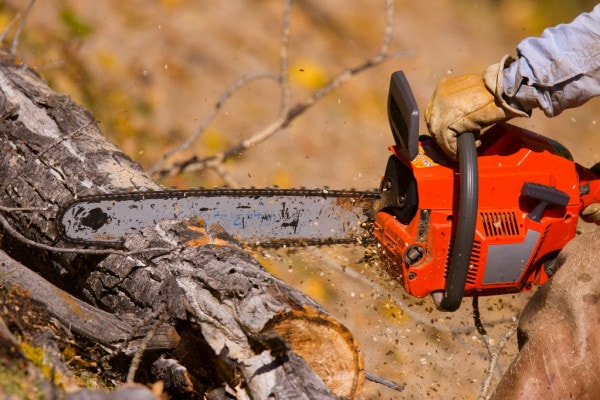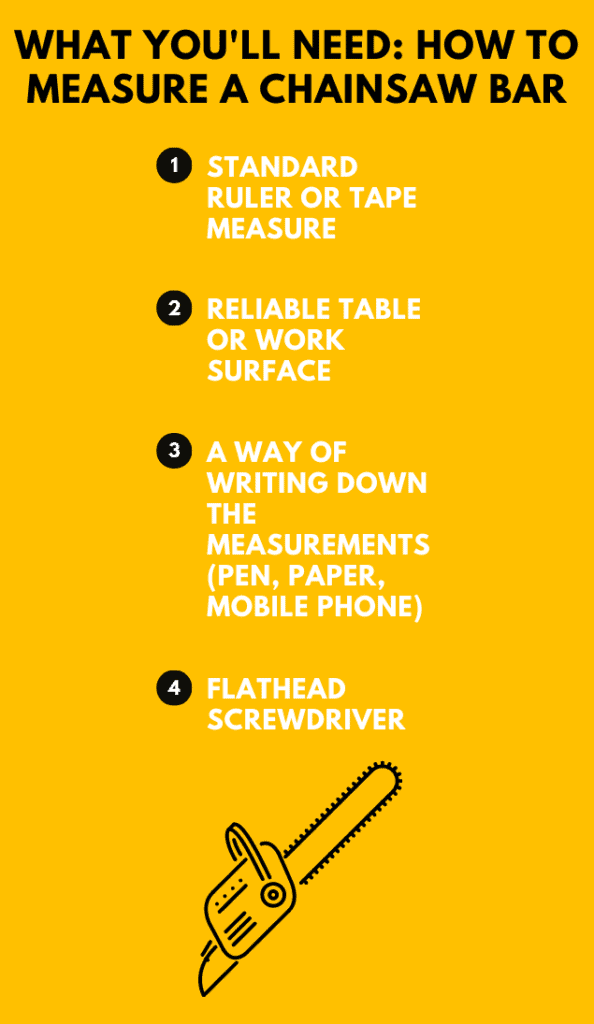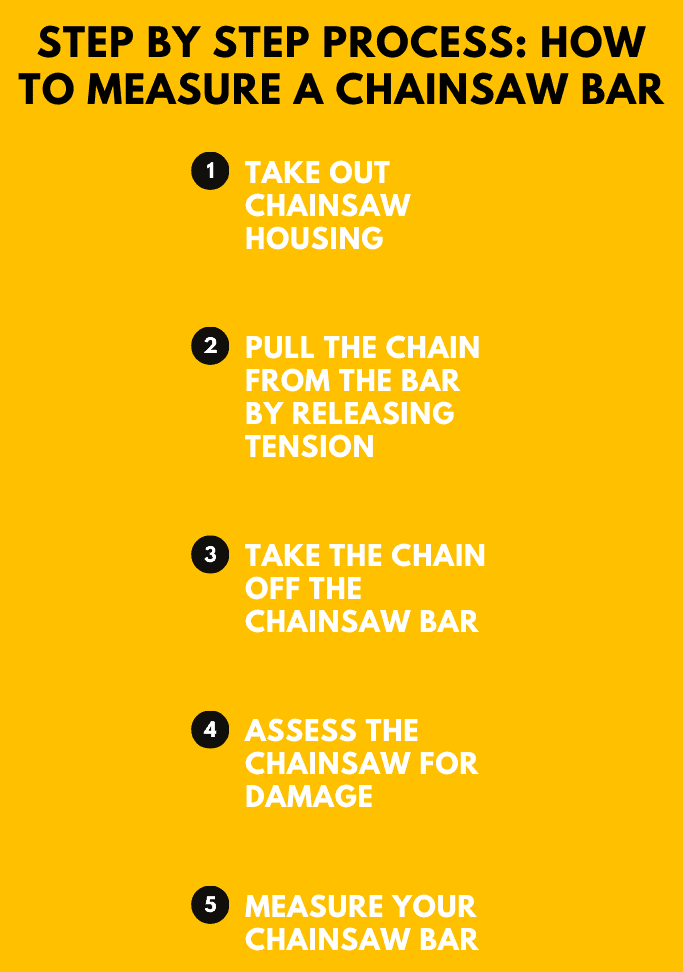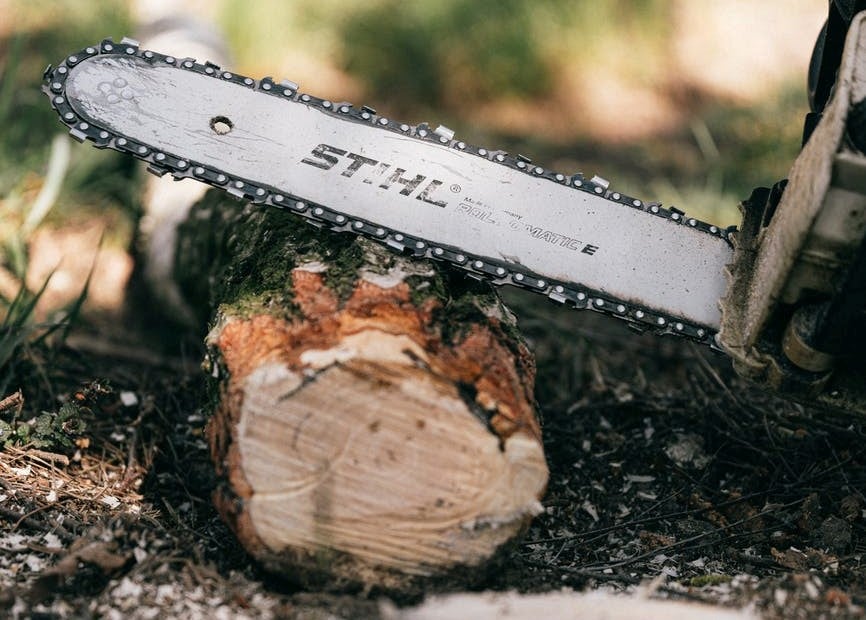
If your goal is to find a quality replacement chainsaw bar, you must know what size to get. Without accurate measurement, you may have to run to the store a second time. But how do you measure a chainsaw bar and get the most precise measurement without wasting your valuable time?
Below I dive into everything you need to know before measuring your chainsaw bar. I describe what you need, how to get the job done, and more critical insights on choosing the right product.
The saw body houses the engine or motor, but the bar and chain are also vital components of the operation. Knowing the correct measurements allows you to make the right decision in purchasing a new bar.
YouTube Video
Are you looking for a quick video to learn the essentials in measuring your chainsaw bar? Click here.
What You’ll Need

There are a few items and pieces of information you will need to measure the chainsaw bar accurately:
- Standard ruler or tape measure – the tape measure might be more convenient, but either method will work.
- Reliable table or work surface – allows you to keep everything stable and safe while performing measurement.
- A way of writing down the measurements (pen, paper, mobile phone). You want to remember this information so you can give it to the store employees.
- Flathead screwdriver – when you locate the tension wheel, the flathead screwdriver helps you remove the screws and pull the chain from the grooves.
Next, you will need to understand the two different bar length types: cutting length and overall length. Many chainsaw owners get confused about the difference and purpose of each length type.
The cutting length is the actual measurement you need to find when performing the steps below. I want to add you are not required to know the overall bar length. This concept is true for all makes and models like Echo, Husqvarna, Stihl, and others.
Not every chain or bar is the right idea for every saw. Bigger chainsaw bars will pair better with a more powerful saw because it requires more energy to drive the chain around a longer bar. For this reason, electric saws will use bars that are less than 18 inches.
Step by Step Process

Now that you have the right tools, it is time to begin the measuring process. Removing the blade and chain is the most efficient method to get the most precise measurement of the chainsaw bar.
If you have standard knowledge of chainsaw parts and tools, this step is straightforward. Setting aside the blade will also allow you to check for damage.
Step 1: Take Out Chainsaw Housing
First, you will need to remove the pair of nuts that are attached to the housing. You can find the nuts within a set of sockets, close to the handle.
After you take out these nuts, you can do the same with the housing. Behind you will find the chain, saw bar, and drive bush.
Step 2: Pull the Chain from the Bar by Releasing Tension
Next, you will need to find the tension wheel, which is just within the chainsaw bar. Utilize a flathead screwdriver to rotate the screw leftwards. Doing so will release the tension and guide the chain away from the bar’s grooves.
Go through each groove and remove the chain carefully. You should continue to remove it until you get to the drive sprocket.
Step 3: Take the Chain Off the Chainsaw Bar
After you reach the drive sprocket, pull the chain off completely. You will then see the drive gear, which is a wheel positioned beneath the handle.
Step 4: Assess the Chainsaw for Damage
Once you take out the chain, you can remove the bar or blade. As you do so, check to see if the bar needs to be replaced or repaired. I have made a quick checklist for you so you can effectively analyze and record any chainsaw damage:
- Note any details related to the company, manufacturer, and equipment
- Assess whether the chainsaw is electric or fuel
- Outline the intended uses with the chainsaw
- Locate and write down any substantial risks
- Consolidate the risks, measure, and risk controls
Step 5: Measure Your Chainsaw Bar
Set the blade on a flat table or surface to make sure you get an accurate measurement. You can measure the blade or bar with a standard ruler. Make sure you measure and record the bar from end-to-end. This bar is also referred to as the called length or cutting length.
When you perform the most accurate measurement, you must start at the front tip. Track your measurement to the cutter, which is at the front of the saw’s body. Once you get the number figure, round up to the next even number in inches.
Another option is to take the blade to a nearby hardware store. The professionals can either measure your current one or grab a new one for you.
What Do the Numbers Symbolize on a Chainsaw Bar?
The numbers on a chainsaw bar tell you a lot of critical information. This number represents a unique identification code, which is used by the manufacturer to provide the chain’s gauge and pitch measurements. The gauge and pitch are critical because they impact whether the chain pairs well with a chainsaw or not.
Bottom Line

As you can see, you can accurately measure the chainsaw bar length by following a simple process and applying basic chainsaw part knowledge. The most important takeaway is to analyze details closely. If you do not remove the chain or nuts, you will not get a precise measurement. I highly recommend taking your time in getting this figure so that you can give the right number to the store professionals.
When you finally report the numbers at the hardware store, focus on the cutting length, not the overall length. Doing so will help you choose the perfect bar to use your chainsaw effectively.
Are you looking for more? Check out some of the other article I have written:
- Lacquer vs Polyurethane: What is the Difference?
- Different Types of Hammers and How to Use Them
- The Best Whittling Knives in 2021
- The Best Multimeters in 2021 – Review & Buyers Guide
- How to Remove Gorilla Glue from Skin – 4 Different Methods
- 22 Artistic & Creative DIY Pallet Sign Ideas
- DIY Gifts for Friends That Have Everything
- 22 Doable DIY Projects for Men That Still Look Cool
- The Best Harbor Freight Circular Saws in 2021
- The Best Ryobi Table Saw Parts: Buyers Guide
- The Best Craftsman Chainsaws in 2021
- Stihl Chainsaw Dealers Near Me
